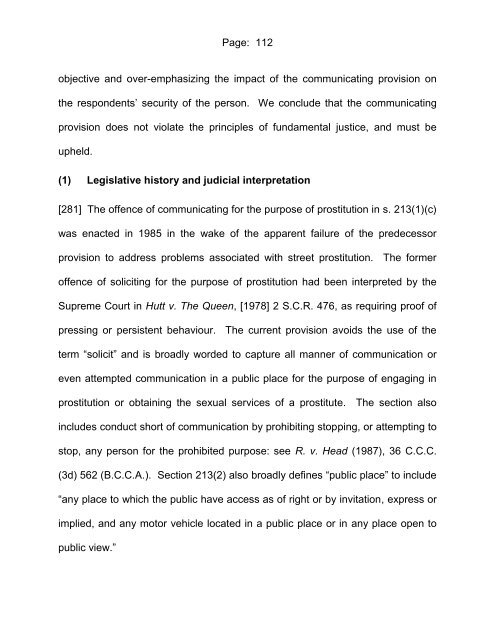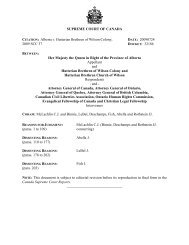Canada (Attorney General) v. Bedford, 2012 ONCA ... - York University
Canada (Attorney General) v. Bedford, 2012 ONCA ... - York University
Canada (Attorney General) v. Bedford, 2012 ONCA ... - York University
You also want an ePaper? Increase the reach of your titles
YUMPU automatically turns print PDFs into web optimized ePapers that Google loves.
Page: 112objective and over-emphasizing the impact of the communicating provision onthe respondents‟ security of the person. We conclude that the communicatingprovision does not violate the principles of fundamental justice, and must beupheld.(1) Legislative history and judicial interpretation[281] The offence of communicating for the purpose of prostitution in s. 213(1)(c)was enacted in 1985 in the wake of the apparent failure of the predecessorprovision to address problems associated with street prostitution. The formeroffence of soliciting for the purpose of prostitution had been interpreted by theSupreme Court in Hutt v. The Queen, [1978] 2 S.C.R. 476, as requiring proof ofpressing or persistent behaviour. The current provision avoids the use of theterm “solicit” and is broadly worded to capture all manner of communication oreven attempted communication in a public place for the purpose of engaging inprostitution or obtaining the sexual services of a prostitute. The section alsoincludes conduct short of communication by prohibiting stopping, or attempting tostop, any person for the prohibited purpose: see R. v. Head (1987), 36 C.C.C.(3d) 562 (B.C.C.A.). Section 213(2) also broadly defines “public place” to include“any place to which the public have access as of right or by invitation, express orimplied, and any motor vehicle located in a public place or in any place open topublic view.”
















